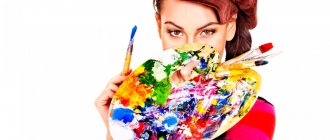Yellow color in the interior helps to uplift the mood and can be used both as a main tone and as an accent color in patterns on fabrics, ceramics and household utensils. Proper use of color, taking into account preferred combinations, can radically transform space and create a cozy atmosphere in an apartment or house.
Red color
It is the most basic stimulating color. It is not recommended to use red in large quantities in the interior. Since this can lead to fatigue in people who are excitable and imaginary and prone to anxiety. It is also not recommended to use this color in a room where people with high blood pressure are constantly present.
But if you use the red range extremely carefully and carefully, you can achieve the completely opposite result. Precisely because the color red by its nature can give a person optimism, energy and self-confidence. According to its physiology, red is able to improve blood circulation, sexual desire, and releases adrenaline. The reverse side of red is apathy, aggression and anger.
Based on the psychology of the color red, it can be used in the interior when decorating a kitchen, hallway, staircase, gym or office.
Everything about the rules for choosing the color of furniture, interior design and the psychology of colors on the human body
Color therapy is an ancient science. It appeared in the IV-III millennium BC. The founders of color therapy were China and India. This science was highly valued by famous scientists of that time - Avicenna, Hippocrates, Paracelsus. Colors were prescribed to treat various ailments. Doctors recommended covering windows with curtains of a certain color and taking baths with colored water. Wearing colored clothes also produced the desired effect.
Today, these color therapy techniques have been preserved. You can use different colors to organize the interior of the room, use shades in clothes and surrounding objects. If you choose colors wisely, you are guaranteed success in life.
Color combinations. Contrasting are 2 colors that are opposite each other. Related - located in the same color sector. The sector is located in the sector between the primary colors: red - yellow, yellow-green, green-blue, blue-red. There are 4 sectors in total. Related-contrasting - colors from two adjacent sectors
Psychologists talk about the different effects of color on people. Do not neglect the advice when choosing furniture for yourself and your loved ones. The choice of color in the interior of your home largely determines the atmosphere that will reign in it. Therefore, it is important to make an informed choice of colors. First of all, the color in the interior should be in harmony with the inner world of the household. Chromotherapy is the therapeutic effect of color on the body. It is used to prevent and treat diseases and stressful conditions, such as sleep disorders, headaches, chronic fatigue syndrome, nervous disorders, musculoskeletal diseases, respiratory organs, digestive organs, heart and blood vessels, joints, etc.
In many ways, the color of the interior depends on the taste and personal preferences of the home owner. Every person eventually faces the solution to a similar problem. Lately, people have begun to think about the impact of the chosen color on their mood and even their well-being. Each color has a specific effect on the subconscious, as well as on the physical and emotional state. The duration and intensity of exposure to certain colors have specific meanings. Some colors can evoke positive emotions, others negative. There is an opinion that women are more sensitive to color and its shades than men .
The second point that is important to consider is the psychology of color. Therefore, it is important to know exactly what influence is typical for each of the basic colors.
And, the third point that is important to say is that the choice of color depends on the nature and purpose of the rooms in your home. Warm, active colors are perfect for the kitchen, dining room, living room, but for our places of relaxation and rest we need calmer and muted tones.
Here are some simple tips:
- melancholic introvert - furniture in warm colors (yellow, coral pink, scarlet, orange). Such tones will help you improve your performance and activate the capabilities of your body;
- extrovert - you better choose tones that can bring calm: blue, green, indigo;
- optimist your color is pink.
By the way, experts say that this color can slow down the aging process, but you shouldn’t overdo it, otherwise you might fall back into childhood. White color in the interior. - In Western culture, white is associated with purity and elegance. It’s not for nothing that this is the color of weddings, celebrations, and angels. White color in the interior can open up the space and let in more light and air. However, an excessive amount of it can make the interior lifeless and boring. Its incorrect use can cause unpleasant associations - with hospital wards and sterility. Therefore, the white color must be “softened” using various shades (baked milk, ivory, etc.). As well as different textures on walls, textiles and floor coverings. This will help make a white room warmer and more attractive - both perceptually and physically. White color symbolizes cleanliness, health, freshness, cheerfulness and lightness. Due to this color, you can increase the illumination of the room, but also visually increase the space. White color is successfully used in a small space to enhance the lighting of the room. It is also used as an excellent background for bright interior elements. The white color scheme inspires, invigorates, encourages action, however, it should not be used in large quantities in bedrooms. An excess of white color negatively affects intimate relationships.
Psychologically, white color helps relieve tension, free yourself from annoying thoughts, concentrate, discard everything unnecessary and make the right decision.
Black color in the interior.
- The most commonly used color is black. It is versatile and goes well with other colors.
- If there is a lack of lighting, do not overuse black. This color goes well with mirror surfaces. Although black symbolizes emptiness and denial, it is still among the most sought-after colors not only on the world's fashion catwalks, but also among famous furniture manufacturers. Design experts recommend its use in bedrooms.
The correct use of black in the interior can emphasize the atmosphere of sophistication and elegance. It will perfectly highlight details against a background of light or neutral colors, highlight architectural nuances, pieces of furniture and decor.
Black is often used to convey an air of power, authority and social prestige (think black Mercedes, black tuxedo).
- However, be careful and use it very sparingly. Otherwise, he can create a threatening, dark, oppressive environment. Constant exposure to the color black can negatively affect a person’s psyche, suppress him, and create a feeling of depression and hopelessness.
- Even if you find yourself in a difficult life situation and you are involuntarily drawn to black colors, take a step to the side and reduce the amount of it in your life.
- It is perceived by us as difficult and can set a person up for melancholy and despondency, lead him into loneliness and isolate him from the outside world. These are the disadvantages of black.
- Among the advantages, the following can be highlighted: this color allows you to focus on spiritual ideals; with its help, you can isolate yourself from external hustle and bustle and concentrate on solving complex problems or internal crises. Black is very elegant and sexy and at the same time it looks businesslike and serious. It is believed that black color has sophistication and culture, it seems to be opposed to the whole range of vulgar colors
- For children, black color is categorically contraindicated - children, even in adolescence, are very delicate and impressionable natures. Therefore, there is no need to deprive them of the colors of life and normal living emotions, even if your child follows some fashionable musical trend and insists on a dark interior.
- Brown color in the interior.
- Shades of brown evoke associations of comfort, home, and warmth. Brown color is perfect for the element Earth and the primary element Wood. After all, nature is full of brown.
This is why the psychological impact of the color brown is often described as reassuring, creating a feeling of security, stability, groundedness, solidity, common sense.
- A large amount of brown in the interior helps to make calm, informed decisions.
- Brown is wonderful for the interiors of those people who, due to their occupation, are forced to spend a lot of time in bright, colorful places or constantly move around and meet a lot of people. This color in the interior is also suitable for those who work or relax in places with loud music, multi-colored decoration, and illumination.
- Psychologists note that brown color is often chosen by people in need of psychological relaxation and detachment from bustle and worries. Those who are in search of ways to express themselves, their own style and something they like, reject brown. Thus, the predominance of brown in the interior can be recommended to accomplished, self-sufficient, self-confident people.
- In interior design, brown can add warmth and depth. It can warm up cool or neutral color combinations and make a room feel more comfortable and cozy.
The neutral color that best suits cabinet furniture is brown. Light tones of this color are ideal for kitchen or bedroom interiors.
- Brown color has a calming effect that adds strength; it creates the impression of perseverance and good quality, freeing up the flight of imagination. According to some beliefs, this color can have a beneficial effect on your financial situation.
Gray color in the interior.
- The correct use of gray in the interior can give an elegant rigor, which at the same time will not be boring and conservative. Use it if you want to create an atmosphere of calm, reliability and trust. This works best when paired with white and other neutral tones.
Gray color in the interior can be an excellent background for other, more intense colors. If you choose the right shade of gray and use it with bright colors such as pink, fuchsia, turquoise, or orange, it will unify and harmonize the overall look.
The danger with using gray is that if the color covers too many surfaces without combining with other colors and bright accents, it can create a dull, dull and even ominous atmosphere.
A gray background can serve as a wonderful backdrop for luxury items. It is believed that this color can help relieve stress by being practical and calm.
Red color in the interior.
- Red is an extremely powerful color. As with other colors, the psychological effect of red depends greatly on its intensity. It has been established that bright shades of red cause a person to have a rapid heartbeat and increase blood pressure. But you can feel quite comfortable among muted, warm brownish shades of red.
The color red is also associated with danger (think fire, brake lights). But it is also the color of action. Do not overuse red in the interior. It visually brings the walls closer and narrows the space. But as an accent or even the color of one of the walls, it can be very effective if you want to give the atmosphere a mood of cheerfulness, encouraging action and activity.
Red color in the interior should be used in rooms where you meet with friends, spend time actively and should be avoided in places where you need rest and relaxation.
Shades of red emphasize luxury, wealth and beauty. This color is believed to induce positivity. Designers recommend using red tones when decorating the interior of a kitchen, hall or living room. Care should be taken when using this color for children's rooms and bedrooms. In this case, you should choose the right shades.
- Shades of red create a feeling of joy, fun, activate the subconscious, helping to raise a person’s vitality, and stimulate his determination.
- It is assumed that it has a healing effect, has a beneficial effect on the functioning of the liver, kidneys and circulatory system. In addition, the color red increases sexual activity in people.
Orange color in the interior
- Orange is the warmest color. It is perceived as emotionally stimulating, energetic, lively and fun.
Rich orange attracts attention and stimulates the appetite. That is why it is often used in advertising, cafe and restaurant interiors. The effect of orange depends on its intensity (it can be more yellow or more red) and its hue (dark, neutral or light).
- Orange has its greatest impact in its pure form, when it is not lightened, darkened or mixed with other colors. It becomes softer in its pastel and earthy shades.
- The yellow-orange robes of Asian monks evoke feelings of spirituality and tranquility. On the other hand, in Mediterranean style, orange is mixed with brown tones to create different shades of terracotta. These shades convey the warmth and richness of southern countries.
Orange color in the interior can energize, uplift, invigorate, inspire confidence, evoke positive feelings and joyful emotions. Therefore, it should be used in those rooms where you want to feel exactly this state.
Orange shades of color encourage communication and create an atmosphere of harmony. Orange color has a relaxing effect not only on the emotional, but also on the physical level.
- Orange tones are used by designers for living rooms and kitchens, since it is in these rooms that family members most often communicate.
- It is most appropriate to use these tones in a room that is reserved for a child’s activities, since the orange color promotes fruitful mental activity, increased energy and mood, and is conducive to work.
- The color symbolizes joy and activity. Has a beneficial effect on the functioning of internal organs. Green color in the interior
- A lot can be said about the benefits of green, but its main property is its positive effect on the eyes. Unlike other colors in the spectrum, green is perceived by the eye without distortion. Green color in the interior is associated with wildlife, herbs and trees. Perhaps that’s why it helps you relax, calms you down, and brings pleasant thoughts to your mind. This color in the interior is ideal for meditation, and just relaxation after a busy day at work. Green color has a calming effect, rejecting bad energy and negative emotions. This color can be safely used when designing the interior of a bedroom or children's room. This color has concentrating abilities that help achieve good results in work. For this reason, work rooms are often designed in these colors. Green is rightfully considered a symbol of movement and growth; it helps to calm down and find self-confidence. It has antiseptic properties and has a positive effect on the growth and strength of muscle tissue.
- Yellow color in the interior
- Yellow is rightfully considered the “warmest”. It is recommended to use this color in the interior of rooms located in buildings on the north side. It is believed that warm yellow tones have a positive effect on the liver and digestive organs, increasing appetite. Sunny color is the color of optimists; it helps in achieving the desired result. Symbolizes intellectualism. Positively affects the nervous system and skin.
Psychologists say that yellow is the happiest color of the spectrum; it inspires optimism and joy. The abundance of yellow in the interior can quickly tire you.
- Yellow is the brightest, warmest and most cheerful color for a children's room. Children love him very much! It simulates activity well, sociability, and helps maintain physical tone, and this is exactly what children need for full development.
- Taking into account the influence of yellow on intellectual functions, use it to decorate your study space. In combination with red, it can increase the thirst for knowledge and push the child to learn something new. This color is not suitable for the bedroom; it is overly bright and stimulating and will not give you the opportunity to properly relax.
Blue color in the interior.
- For many people, blue is their favorite color.
In the interior, you can use blue to create an intellectual atmosphere that brings clarity to thoughts. It is practically impossible to feel increased aggression, emotionality or overexcitement while in a cold blue environment. The color blue lowers our blood pressure and heart rate.
- It can also symbolize kindness, fidelity, constancy, favor, and in heraldry it denotes chastity, honesty, good reputation and fidelity.
- You can use blue in your interiors to cool down hot, sunny rooms. Obviously, blue color will not lower the temperature physically, but psychologically we will feel cooler. The opposite is also true; if you add blue to north-facing rooms, the space can take on a chilling tone.
The wide range of shades of blue affects us in different ways. Blue - brings peace and tranquility, allows you to understand yourself, turquoise - stimulates performance, helps increase our self-esteem, and relieves stress. Indigo is a rich, deep blue associated with intuition and understanding.
- The color blue also conveys a sense of trust, which is why it is often used in advertising for banks and other financial institutions. Light blue is a combination of blue and white, so it combines the effects of both colors. One part of it helps you relax and calm down. It creates a cool and refreshing effect. The second part stimulates the imagination and promotes attentiveness. Blue color is often found in school classrooms and office spaces. Blue is also good in the office, in the room where controversial issues are resolved and conflict situations are frequent.
- In combination with yellow and red, blue is suitable for decorating children's rooms. It contains a playful element, we can also combine it with pink, light green, ocher, orange, lilac and other colors that will make the baby’s room cheerful.
Using delicate shades of blue and blue in the interior is most useful. An atmosphere of calm is created, allowing you to relax and calm down.
- Most often, these colors are used in design projects for bedrooms. Desaturated and fresh tones are used here.
- Blue and cyan colors have a negative impact on appetite, so their use should be meaningful. But those who want to lose weight can use it to their advantage: the color of the walls, tablecloths or dishes will help in this case to reduce their appetite.
- It is believed that such colors contribute to the development of intuition. “Blue blood” has always been considered a sign of nobility, so it is not surprising that the color itself symbolizes spiritual nobility.
- Some scientists believe that the color blue helps in the treatment of deafness, cataracts, bleeding and insomnia. It has calming properties that constrict blood vessels, having a positive effect on sleep.
Purple color in the interior.
- Purple color is quite complex both in terms of perception and in terms of its origin. In the west, purple is the color of royalty. The Roman Emperor Julius Caesar decided that he would be the only person allowed to wear purple.
When it comes to interiors, purple can be that rich and complex color that brings true luxury to a room. On the other hand, there is a danger that purple in the interior in its wrong combination and shades can look bright and cheap.
The psychological effects of purple depend on the “warm” or “cool” shades you use. Violet with blue notes can have a calming effect and impart a mystical depth. Reddish purple is likely to dominate the room, so it should be used with caution. In general, it is better to give preference to light shades, since deep dark colors can cause nervous tension and even psychological instability.
Violet tones are most often chosen by people who are inclined to philosophy. This color is considered one of the most mysterious. Purple has a beneficial effect on the formation of mental flow and observation.
- True, designers do not recommend focusing on this color. Do not forget that dark shades of purple are a little tiring. Although this color symbolizes mental abilities, the use of this color in the interior of residential premises should be minimized. It harmonizes with many other colors.
- Violet tones help reduce pain and temperature, relieve migraines, insomnia and depression, restore and strengthen the nervous system, and bring calm.
- Typically, little girls prefer lavender, especially when combined with pink. Lavender is Barbie's favorite color, so don't expect boys to want to live in a similar atmosphere either!
- Pink color in the interior.
- Pink color has a very wide palette of shades. The color pink creates an atmosphere of tenderness, softness and care. It symbolizes femininity, happiness, positivity. We often associate the color pink in the interior with a girl’s children’s room. However, there are many exquisite shades of pink that famous designers use in their work for both men and women.
The psychological effect of the color pink is that it calms, relaxes and softens us. Pink tones have an amazing property: they neutralize the aggressiveness hidden in many of us and provoke friendliness. Its violet (red-violet) hue indicates that it is most often chosen by people who do not recognize slavery (their motto is freedom in everything). It allows us to focus on the inner world, makes us more sensitive and sentimental. Therefore, if you are a very sensitive person, it is better for you to avoid it, so as not to aggravate this quality, but to compensate for it with those colors that will give you determination and bring you back to earth.
- Pink color – symbolizes romance, kindness, love and passion. He is fueled by an aura of innocence and purity.
Pink is a mixture of white and red. Tenderness, masculinity, lightness, inspiration, strength, stability and self-love “live” in this color.
- Pink tones help in times of crisis. Often, interior elements in pink shades are used for meditation, as they can evoke a feeling of security and happiness, while increasing the overall immunity of the body. And doctors say that shades of pink help with insomnia, promote peace and reduce blood pressure.
- There are methods for arranging flowers depending on the purpose of the room. For example, a bedroom or study is not a place for rich colors. If you create wide, monochromatic spaces, the color will act depressingly. Contrast is not the best solution for break rooms and work areas. Incredible acid combinations used to be all the rage. But experience with the use of contrasts has shown that they contribute to the development of nervous disorders. It is possible that bright combinations will be appropriate at a disco, but it is better not to use them at home.
- Adding other color accents to the main color of the interior will make the room more interesting and pleasing to the eye. So, the main color of the interior is green. Additional colors: blue, light green, yellow, lime, black. The main interior color is blue. Additional colors: gold, turquoise, silver, white, red. The main interior color is red. Additional colors: pink, white, silver, orange, gold, black, blue.
- The energy of color is the shortest path to harmony and success. If you use color therapy techniques, your life will soon change for the better.
You can consider several methods of how colors affect a person:
- ACCENTS. Some colors have a strong effect; if they are in excess, the effect can be negative. Therefore, you should not completely stick to one color. For example, small red wardrobe items will have a positive effect on vital energy. You can use multi-colored pillows in the room, arranging them according to the method. Then the energy will spread throughout the room.
- LAMPS: The light from lamps can be not only white. Bright lampshades will fill the room with the right color.
- DECORATIVE STONES: The color of the stone affects your health and emotional state. Colorful minerals on the shelves will not only be a pleasant addition to the interior.
- FLOWERS: Beautiful flowers have a similar effect. Bouquets can be made in the same color scheme, or you can use different colors.
- LIGHT: In the theater, special filters are often used that change the light of the lamps. Use them in your interior.
- FOOD: Creating dishes from colorful foods is taking care of your digestion.
BRIGHT WINDOWS: Stained glass is a well-known decorative technique that has been around for many years. Today, a similar rainbow can be created using stickers.
Orange color
This is a life-affirming and invigorating color that does not have cold undertones. This color comes from a mixture of red and yellow. From the first he got activity, from the second - warmth and kindness. Therefore, even if you use orange in large quantities indoors, it will not cause irritation. In the interior, it creates the impression of friendliness and a comfortable environment, filling the room with light, warmth and optimism. There is also an opinion that this color stimulates brain function.
“Orange” color is suitable for those who want to further enhance the feeling of cheerfulness and warm cheerfulness in the interior. Orange is also useful where increased activity and friendliness are needed: in the office, in the kitchen, in the study, in the dining room, in the library. Most often, pure orange is used as a bright accent in the form of accessories.
For a country house
Quite often, a dacha is made of wood, lined with clapboards, or natural logs are left. And the yellow color goes very well with wood. Therefore, if you choose yellow for your country house, it will warm it up on autumn and winter days, and you will always be in a bright mood for fun and relaxation. It should be recalled that all this concerns an absolutely pure and bright yellow color. Any other shades of it: paler and more transparent, lemon, rich yellow-orange and others - contain impurities of other colors and, accordingly, the above does not apply to them.
Yellow
Very intense color. It is the color of happiness, sun, freedom, fun and therefore creates an optimistic, invigorating mood. Yellow encourages new ideas and the correct acceptance of different points of view. It goes well with other warm colors. Warm shades always carry only a positive charge.
Yellow color can be used where temporary concentration and self-organization are needed. For example, in a study, office, perhaps in the living room or kitchen. Since this color also increases cognitive interest along with improving memory, it can be used to decorate the interior of a child’s room, but in small quantities. Otherwise, children will be too alert and active, especially before bedtime.
The psychology of yellow color for the interior has both positive and negative qualities. For example, yellow is not recommended for use in rooms where people with insomnia or stomach diseases live.
How does it look when finished?
If we consider yellow color as the basis of the design concept, that is, paint all the walls with it, then let it be a calm, discreet shade. Even a convinced optimist or an exalted nature will not bring joy to whole days spent in a canary or banana reality.
When the soul asks for bright colors, and there is also a desire to zone the space or adjust the geometry of the room, it is better to make only one of the walls or a fragment of it yellow, and then play with this decision in furniture, curtains and decorative items.
It is not necessary to use continuous coloring - vertical or horizontal stripes will do. In the first case, you will solve the problem of a low ceiling, and in the second, a room that is too narrow, more like a corridor.
Speaking of the ceiling: it is quite possible to paint it some light shade of yellow or install appropriate stretch fabrics to enhance the feeling of lightness and warmth, but you need to be careful - this technique is only appropriate in spacious rooms with ceilings no lower than 2.7 m .
Yellow flooring is an easy to implement and successful idea for almost any living space, including limited ones, but the smaller the area, the lighter and more natural the tone should be.
In the photo, the bright yellow stretch ceiling in the living room is successfully combined with the same wall decor
Blue
This is the color of the sky, relaxation, ice, cold, purity, sincerity, tact and calm. Blue simultaneously has the ability to pacify through words and inspire creative ideas. It all depends on the shade and energy you want to draw from it.
In interiors with a blue color scheme, it is best to practice meditation, relaxation, and contemplation. For insomnia, this color helps you fall asleep and treats certain diseases (fever, cuts, high blood pressure, burns, migraines, teething in children).
Blue color is used both in work spaces and bedrooms, as well as in medical institutions and resorts. It should be noted that if there is an excess of this color in a room, there may be disagreements and scandals between the inhabitants.
Tones
Shades of dark green and emerald represent courage, intelligence and determination. Dark green also activates brain activity and promotes self-confidence.
Turquoise, considered one of the shades of green, has a similar but softer effect and represents serenity and constancy.
The use of green and turquoise shades in the interior will bring notes of freshness and coolness into the room, which will have a tonic effect on the body.
Blue color
It is a fresh and relaxing color. It embodies calmness, serenity, leisurelyness, lightness, depth. It can free a person from fussy thoughts and unnecessary negative worries, plunging him into an element of peace and coolness.
A blue bedroom interior is an excellent solution for a person living in a “constantly moving” metropolis. Various shades of blue can be used in a children's room. For example, decorate it in a marine or Mediterranean style. Using the meaning and psychology of blue, it can be safely used in the interior of the bathroom.
Blue has the ability to visually increase the space in depth and height, just what is needed for small rooms. However, in large quantities, blue color negatively affects the human psyche. It can plunge him into apathy and despondency.
Green color
This is a universal color. It symbolizes life, nature, spring, harmony, nature and kindness. Shades of green have different energies. Light shades are intended for those who are in search of joy, new beginnings, constant renewal of life, meetings and travel. A conservative person will like a serious and stable dark green color.
Green color helps in case of negative mental states and some diseases (claustrophobia, flu, bronchitis, lung and heart disease), it brings people together, fills them with harmony and promotes important decisions.
Since this color has a predisposition to both relax and encourage action, this range can be used in the study, in the office, in the bedroom, in the kitchen, in the bathroom, in the living room, in the nursery, and in restaurants. .
Brown color
It is the color of reliability, endurance, devotion, common sense and hard work, representing the color of the Earth. It helps you feel the ground under your feet and concentrate. Also, brown color prevents wastage and waste of time and effort when achieving your goal.
The flip side of brown psychology is boredom, fear, depression, disappointment. All this can be caused by the wrong shade of brown or overuse.
It is noteworthy that the color of wood is appropriate in any room: in the living room, bedroom, nursery, bathroom, cafe, office, kitchen, corridor, etc. These are cream shades, and red-brown, and yellowish-brown, and dark chocolate, and brownish-ocher, and the color of coffee with milk, etc.
The only thing is that dark browns should be used in small quantities, but light, warm and neutral browns can be used in any proportions.
Purple
It is a mystical and majestic color that symbolizes sublime aspiration, fortitude, wisdom, artistry, power, nobility and inspiration. Violet can teach you to accept difficult problems with a calm heart. It can also calm the soul and nourish it with the necessary energy. The color violet helps with neuroses, despair and loss of self-confidence. This color is not recommended for use in rooms visited by people with alcohol addiction and mental illness.
Purple serves as a balance at the two ends of the color spectrum (between red and blue). This is probably why it can balance male and female energy in the human body.
Purple color is not a natural color, and it should not be used in large quantities in the interior. It is better to add accents of purple flowers, which will create an extravagant atmosphere. You can see what shades this color goes with in one of the color combination tables.
Colors in the interior: a classic approach
Traditionally, in painting and design, the color palette is divided into cold and warm shades. Shades of red, brown, orange - from orange to soft peach - and yellow belong to the warm range. And blue and blue are considered cool colors. Green and purple occupy an intermediate place and, depending on the shade, can be either warm or cool. For example, light green is more warm, while emerald green and sea green are cooler. The same is true for the color violet, which is divided into blue-violet (cool) and red-violet (warm).
There are also shades that are not included in the spectrum, but they can also be divided by temperature level. So, pink is warm, although cooler than red, and white is cold and even cooler than blue. The association with snow also plays a role here.
The division into cold and warm shades is only partly connected with aesthetic feelings and is certainly not a whim of artists. Psychological studies have confirmed that at the level of sensations, colors are perceived as warm and cold. Therefore, in a room with an interior in red and orange, it seems warmer than in blue and blue, and even more so in blue and white.
Brown shades, although not as hot as red ones, are more comfortable due to their warmth and naturalness. Most often, brown is associated with the color of wood and bread, while lighter tones are associated with nuts and honey. Therefore, this color is also “delicious”, which makes it one of the best for kitchen decoration.
A good designer will also remember that colors can be light or heavy. Light shades make even massive things look light and airy, but the darker the color, the heavier and denser the object painted with it is perceived. And a room in which light colors predominate seems not only filled with light, but also more spacious. And even a large room, in which dark colors of furniture and walls predominate, is perceived as smaller and cramped than it actually is.
Pink color
This color speaks of dreaminess, strong feelings, love, romance, tenderness, and attractiveness. He inspires optimism. The psychology of pink in the interior is such that this color can neutralize aggressiveness and lead to relaxation, get rid of negative thoughts and create a feeling of comfort.
This color is usually used in girls' bedrooms, perhaps also in living rooms, kitchens or children's rooms. Attention should be paid to a sense of proportion in using pink in the interior. An excess can lead to cloying and sweetness.
The ideal option is to use half pink with another color in the room. For example, with white, beige, cream, gray and other colors that suit you. You can also add bright accents to liven up the room.
Combination of shades
Use no more than two shades at a time, as the interior can be overloaded with colors and details.
Also, for the best combination in the interior, use the table of colors and shades.
Popular shades:
- Blue - green or turquoise - adds freshness, relieves fatigue and tension.
- Gray-green is a calm, detached shade from reality. It is considered a traditional version of green in the interior, makes the room elegant, and helps restore internal dialogue and peace.
- Yellow - green - makes up for the lack of light in the winter season, creates additional comfort, creating a good mood and is suitable for both the bedroom and the living room.
- Light green – promotes a charge of good mood. Using the right shade can encourage guests to chat, while brighter tones encourage decisiveness.
- Emerald - most often used when placing accents. Emphasizes the sophistication of the primary color.
- Pistachio and olive are associated with youth and liveliness, while dark ones are associated with experience. It is best combined with delicate tones, as well as wood.
- Herbal is an active color that creates a feeling of cheerfulness. It can be diluted with beige, brown or orange tones.
- Khaki is a restrained color, often found in loft style. Combines with sand, mustard black, peach shades.
- Lime - enlivens and transforms the room, creates an atmosphere of juicy freshness, especially in combination with neutral colors - white, black, gray.
- Mint – suitable for both the main color and details. It has been very popular in the last few years. Suitable for modern styles, promotes relaxation and tranquility. Goes well with many colors and lighting.
Light, pastel colors are more suitable for decorating living spaces, as they help you relax and improve your mood, while deep colors are reserved for accents, because they overload the appearance of the room, making it pretentious.
White color
This positive color combines all the colors of the spectrum. It symbolizes peace, spirituality, serenity, purity, chastity, concentration, virginity. White color has the ability to energize people. If you don’t know which color is suitable for use in life or treatment for you, then turn to white.
The reverse side of white is detachment, emptiness, loneliness. If there is an excess of this color, a person may feel inferiority, detachment or emptiness.
Any bright color will look more intense against white. This color serves as an ideal background for all contrasting colors, while increasing their brightness. It goes well with dark shades.
White color is good for both small rooms and large spaces. Of course, pure white “hurts the eyes,” especially in large quantities. Therefore, instead of pure white, you can use its muted shades. For example, the color of eggshell, lavender, lily, as well as milky or cream color.
Black color
For example, in the East, black symbolizes goodness and perfection, in Japan it is a symbol of wisdom and nobility, in some countries it is associated with tragedy and mourning. This is the psychology of black color in the interior - opposite and versatile.
Black interior is a non-standard and very bold solution. Black serves as an excellent background. This color is especially good for highlighting contrasts and neighboring colors. On a black background they look expressive and elegant.
In the interior, black can be used to paint walls, ceilings or even floors. Don't be afraid to experiment and use black. In the right cases, it looks noble and respectable.
Naturally, black ceilings or walls are best used in high, spacious rooms. This will bring the ceiling closer to your advantage. But in low rooms, of course, only a light color option is suitable. Black color should be used in small quantities, as it suppresses and causes a feeling of depression.











